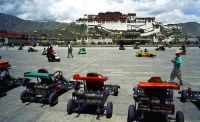Agam's Gecko


Monday, January 29, 2007
INDEPENDENCE AS TIBET'S ONLY OPTION
| I |
have the great honour to present a guest writer today. This essay was included in the World Tibet Network newsletter last Thursday, and its author has kindly given permission to reprint it here. It has also appeared in Phayul and, I believe, in Tibetan Review.
I've spent some time on the formatting, and internally linking the footnotes (click on the footnote's number to return to the text). I've also pulled some images out of my half-vast archives, and a useful map is included above the footnote section. Photo captions are solely my responsibility.
With thanks and appreciation to Ketsun Lobsang Dondup (a pseudonym, for protection of sources within Tibet).
Independence as Tibet's Only Option: Why the 'Middle Path' is a Dead End
By Ketsun Lobsang Dondup
"Independence may be 80 or 90% impossible, but autonomy is 100% impossible. That is why we must work for independence, and be ready for our opportunity when it comes."(Anonymous Tibetan source, 2006)"We are a small, religious, and independent nation. To keep up with the rest of the world, we must defend our country. In view of past invasions by foreigners, our people may have to face certain difficulties, which they must disregard. To safeguard and maintain the independence of our country, one and all should voluntarily work hard." (Proclamation issued by His Holiness the 13th Dalai Lama, 1913)
Tibetan soldiers on horseback carry their national flag sometime before the Chinese conquest (period and photo source unknown)
| C |
hinese officials often exhort critics of China's rule in Tibet to "go to Tibet to see for yourself." The ironic consequence of my own extended visit to Tibet is that it has given me new insights into why independence, no matter how daunting it may currently seem, is the only viable option for Tibet. I come to this view not from the many historical and legal arguments for Tibetan independence, which are of academic concern, quite literally, and which may be debated endlessly with little practical effect. Rather, I base my beliefs in observations and conversations about (i) the uncompromising nature of Chinese control over Tibet, (ii) the negative consequences of the Tibetan government-in-exile's policy of giving concessions in the hope that Beijing will be placated into starting autonomy negotiations, (iii) the slow destruction of Tibet under Chinese rule, and (iv) the necessity, legitimacy, and practicality of working for independence.
Many people argue that the best or only solution for the situation in Tibet is to press Beijing to give Tibet an autonomous status under Chinese sovereignty, known as the "Middle Path" policy.[1] There are generally two justifications for this policy:
(1) the belief that a "realistic" compromise is needed because China would never grant Tibet independence, and
(2) the belief that Tibetans might benefit materially from union with China.
Proponents of autonomy, it should be noted, do not argue based on a desire to embrace Chinese citizenship as such. Each pro-compromise justification has a fundamental flaw, however, as I explain below.
A. Why the Middle Path's Two Justifications are Fundamentally Flawed
1. Beijing will not and cannot compromise:The problem with the first pro-compromise justification is that Beijing has no desire to compromise. In fact, structural factors in the Chinese government's decision-making process reward hard-liners and make it extremely unlikely that moderate solutions will prevail (witness the rise of Hu Jintao and the purges of Hu Yaobang and Zhao Ziyang). No one I spoke with in Tibet had any hope for an autonomous solution, since a necessary but missing precondition is the Chinese government's willingness to compromise. Without Beijing's approval, there can be no autonomy - and any concessions granted by Dharamsala toward that end are a waste.
 |
| Tibetan religious festival, with onlookers. |
This stonewalling makes sense from a Chinese perspective because Beijing calculates it has little to gain but much to lose by an autonomous Tibet, especially when it feels its control is improving thanks to the new railway and the accelerating influx of Chinese settlers that it allows. As Chinese writer Wang Lixiong writes,
"While the Dalai Lama per se might be sincere [about wanting autonomy], as to whether he can control coming developments, and as to how those who come after him will act, he has no control. So when considering the future prospects of the Tibet matter, we have to see Tibetan independence as a possibility that will always exist, rather than holding simplistically that just because the Dalai Lama says that he is not seeking independence, there will be no further Tibetan independence matter." [4]
 |
| The broad plaza at the foot of the majestic Potala Palace, as a go-kart equipped amusement grounds. |
 |
The reason for Beijing's plan to "solve" the Tibet problem through demographics is simple: it realizes it can never truly trust the loyalty of Tibetans. Its rule in Tibet can only be ensured by continuing to move in large numbers of ethnic Chinese. As Wang Lixiong writes, "China's establishment of sovereignty over Tibet hinged not on a military victory, but rather essentially on the ability of the Han Chinese to go there and stay there."[7] Already, some Chinese are starting to think of themselves as "from" Tibet; one Chinese taxi driver I overheard had been in Tibet for eight years, and he was grumbling (in Chinese, of course) about "outsiders" coming in to threaten his livelihood.
With the new railway in place, we can expect an accelerating pace of settlement in Tibet by ethnic Chinese. In Beijing's eyes, the Tibet issue will cease to exist once there are enough Chinese living in Tibet to eliminate any chance of a break-away. Looking throughout China's long history, it used the same strategy against the Manchus, the Mongols, the Uighurs, and many smaller nations or groups whose names are hardly remembered anymore. Why should we expect that in Tibet alone, the Chinese will abandon this time-tested strategy, step back, and give Tibetans the ability to protect our national identity?
2. For Tibetans to prosper in a globalized world, we must have the protection of sovereignty:
 |
| Young Tibetans in India are passionate about freedom for their country. |
The problem with long-term subsidies is that they distort economic and political decision-making, and concentrate power in the hands of those who control the money. Neither outcome is good for development or democracy. As countries with high oil wealth but low political development know, having elites with access to large pools of free money encourages inefficient policies, allows unchecked corruption and nepotism, and makes government unresponsive to the people. Obviously, Tibetans' experience with China should make us especially cautious about being dependent on Beijing. Long-term subsidies also degrade the people's motivation to work hard, because wealth can come from hand-outs from above rather than from work, savings, and investment. This is not the Tibet that we should want.
It is also a problem for a small, relatively undeveloped country like Tibet to link its macroeconomic policies to an exporting powerhouse like China. The economic interests of Tibet and China are simply different. For example, joining the World Trade Organization (WTO) is good for China's manufacturers and exporters, and bad for its farmers. Chinese officials have decided to make this trade-off, hoping that unemployed farmers can find jobs in the cities. Tibet, however, is much more dependent on agriculture and pastoralism than China, and Tibetan cities are not able to absorb unemployed farmers in the same way. So when lower tariffs cause falling barley prices in Tibet, what are Tibetan farmers to do? Tibet would have been better off if it were able to determine when and how to join the WTO (for example, with Least-Developed Country exemptions). Similarly, China is raising interest rates and reserve requirements to cool off its coastal economy, but why should we think this is good policy for Tibet? Tibetans would benefit not from being economically dependent on China, but from being able to shape our own economic policies based on our own circumstances.
Finally, I should mention the enduring relevance of nationhood and sovereignty in the modern world. One only has to look at the E.U. - the most prominent embodiment of post-modern, globalized ideals - to see that states and peoples are still very much concerned with protecting their sovereignty and traditions (for example, see the rejection of the European Constitution). And even in highly developed states like the U.K., Canada, and Spain, one finds nationalism and a desire for self-determination among groups such as the Northern Irish, Scots, Quebecois, and Basques. The experience of the former Soviet Union shows that socialism is no better at erasing nationalism. It is incorrect, therefore, to think that economic development leads to the end of how much a people values its nationhood. The situation in Tibet is no different.
B. The Middle Path's Negative Consequences, Exploited by Beijing
People I spoke with in Tibet said that they see how the Chinese government manipulates people every day, and it is clear to them how Beijing is manipulating the good intentions of the Tibetan government-in-exile. The unanimous opinion that I heard in Tibet was that the Middle Path is not only hopeless, but also dangerous. Henry Kissinger once said that in politics, one never pays for goods that have already been delivered. True to form, China is using the Tibetan exiled leadership's overtures to extort concessions while giving nothing of substance in return. For example, Tibetans in Tibet told me how they heard Beijing spread false reports of inviting the Dalai Lama to China to prevent demonstrations when Hu Jintao visited the U.S. They were ashamed that Tibetans in the West could be fooled by such a ploy. |
| Members of the Tibetan resistance movement, Mustang, Nepal in 1966. |
Beijing knows exactly what it aims to do: stop at nothing to hold down the Tibetans, flood Tibet with ethnic Chinese, and convince the outside world that everything is normal until it is too late to do anything. Do we Tibetans know our goal? Or will we instead continue to be fooled by Beijing dangling hints of concessions and rumors of "reformers" convincing "hard-liners" to change if only we would give just a little more? If so, shame on us.
C. The Necessity of Independence
I will not write about Tibetans' moral, legal, and historical right to independence. Instead, I have two final observations: a conclusion that Tibetans cannot live freely under Chinese rule, and a vision of how Tibet can become free.1.The current repression of Tibetans:
I have written above about the threat of Tibet being flooded with Chinese settlers. The political repression and heavy militarization in Tibet needs no description. Additionally, Tibetans suffer systematic discrimination for the simple reason that the Chinese government distrusts Tibetans so it sets up economic policies that favor Chinese. Unemployment is a big problem for Tibetan youth, as is alcoholism and gambling. Many "professional" Tibetans are either encouraged to take early retirement with full pay (in their 30s or 40s) or only show up to "work" to be photographed at a meeting or two, while Chinese do the real work. On an individual level, Tibetans may see this as taking back from a corrupt system that took so much from them (the saying is, "they took the whole carcass so I took back a slice"), but the larger societal impact is far-reaching and quite negative. In addition, these Tibetans are easily controllable because the government merely has to threaten to cut off their wages; for example volunteering is often seen as too dangerous because it would bring official suspicion. I have no doubt this is exactly the government's intention.
 |
| The Lhasa riots in 1989, thirty years after the national uprising of March 10, 1959, and just a couple of months before the Beijing massacre of the Chinese democracy movement. John Ackerley photo. |
Some Chinese claim that Tibetans in Tibet do not have good jobs because they are less capable: social Darwinism at work. In truth, Tibetans simply lack education and equal opportunity (in comparison, see how successful many have become in Nepal and India). It is not hard to conclude that the economic dominance of Chinese in Tibet is encouraged by the Chinese government, since it suits its primary goal of fighting Tibetan independence. If the government were truly concerned about the Tibetan people, it would focus on education and equal opportunity rather than blaming the Tibetans and making it easier for Chinese to come and set up shop.
2. Independence as the only option:
 |
| Tibetans in exile in a Western country demand freedom for their homeland. |
It has become a cliche' to talk about the break-up of the Soviet Union or the freedom of East Timor. But it is worth noting that until very close to the actual independence of the Soviet republics or of East Timor, the general consensus was that their causes were hopeless (see George Bush, Sr.'s speech in 1991, cautioning Ukrainians against "suicidal nationalism" just months before the Soviet Union crumbled).
China is not the Soviet Union or Indonesia, but then, Tibet is not Lithuania or East Timor because Tibet's cause enjoys even greater prominence and legitimacy for much of the world. China also has deep structural problems such as an inflexible political system, growing economic inequality, rampant corruption and pollution, spreading protests and disorder, and unstable nationalism directed against Taiwan, Japan, and the U.S. As Professor Samuel Huntington explained in his classic, Political Order in Changing Societies, economic growth and the mobilization of new social forces combined with inflexible politics often leads to disorder. Tibet's best hope lies in being able to use the East Timor model to exploit disorder in China to regain independence.
 |
"it is only the military stationed in Tibet that keeps the separatists from shaking Chinese sovereignty. But the test of stable sovereignty is often not stability on normal terms, but rather at particular historic times. The military role in sovereignty is only like a rope, which can tie Tibet to China, but cannot keep our bloodlines together over the long term. In peacetime, the rope is firm and unbreakable, but once a special juncture is reached, the rope can become unbearably weak."[8]The best hope for Tibet is that China will come to a "special juncture" of internal crisis and instability. In this instance, Chinese leaders would feel that their resources should be used firstly to fight instability in China itself, and that it is not worth holding on to problematic Tibet. This is how other empires have unravelled, and there is no reason why China should be different. This outcome is dependent, however, on Tibetans having kept our independence claim alive and causing enough problems for the Chinese regime that it is forced to make a choice.
But first, we Tibetans ourselves must make a choice. Are we going to give, give, give in the impossible hope that the Chinese government - which still insists it was right to kill its own children to hold on to power - will grant Tibetans autonomy and reverse thousands of years of Chinese strategy? Or are we going to reject defeatism, stand up for our inalienable right to self-determination, and work for the day when Tibet joins other formerly-oppressed nations as a free and independent country?
 |
| This National Geographic map shows how the Tibetan Plateau and Tibetan-populated areas are in very close correspondence. The area shown as Tibetan on this map is almost precisely aligned with Tibet's traditional borders. A large part of Tibet's land mass has been carved out into other Chinese provinces, leaving the "Tibet Autonomous Region" in the southwest. |
Footnotes:
[1] In this article, "Tibet" refers to the areas of the Tibetan Autonomous Region, Qinghai, Sichuan, Yunnan, and Gansu that have historically been part of the Tibetan national, cultural, and linguistic sphere. Few outside the Chinese government would argue that the Tibetan Autonomous Region can be considered truly autonomous; however, an in-depth discussion of this topic is beyond the scope of this article.
[2] People's Daily, On the 'Middle Way' of the Dalai Lama, July 26, 2006, available here.
[3] AP, Tibet: No progress for China, Dalai Lama, July 4, 2006.
[4] Wang Lixiong, Tibet: The People's Republic of China's 21st Century Underbelly, published in Beijing Zhanlue Yu Guanli in Chinese on 2nd January 1999, pp. 21-33, translated by the BBC Monitoring Service, published in the BBC Summary of World Broadcasts.
[5] Beijing, of course, denies this. See: China Daily, Railway 'Will Not Cause Settlers to Flood In', July 14, 2006, available here.
[6] Beijing claims that it would violate the "equal rights" of ethnic Chinese to "stop moving people into Tibet and [to say that] Han people already in Tibet must return to China." It argues that "Making non-Tibetans move away from where they have been lived [sic] for many centuries so as to satisfy the Dalai Lama goes against the PRC Constitution and the Law on National Regional Autonomy." People's Daily, supra.
[7] Wang Lixiong, supra.
[8] Ibid.
Ketsun Lobsang Dondup is a pseudonym used to protect sources in Tibet. The author may be reached at KeLoDo@gmail.com.
Labels: Tibet











 Our way of saying "thanks" in the Thai way. Here a nak muay Thai (kickboxer) offers respect and thanks for his teacher (wai khru) before a match. This is our local variation on the ubiquitous "hat tip" used in general blog culture.
Our way of saying "thanks" in the Thai way. Here a nak muay Thai (kickboxer) offers respect and thanks for his teacher (wai khru) before a match. This is our local variation on the ubiquitous "hat tip" used in general blog culture.





